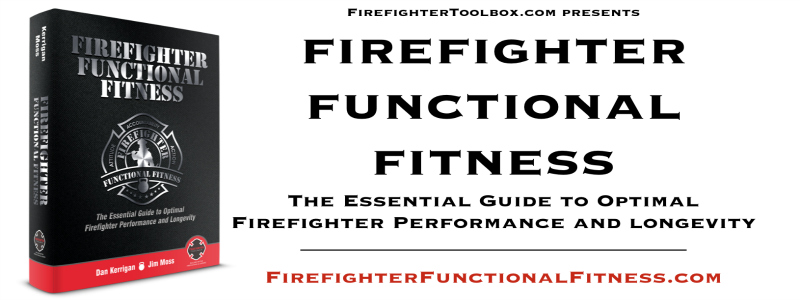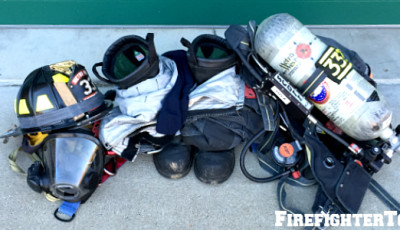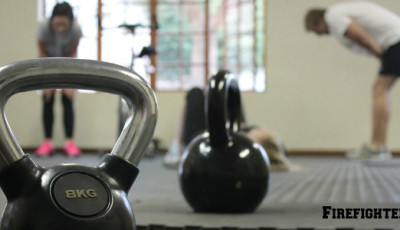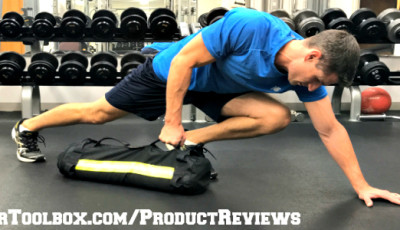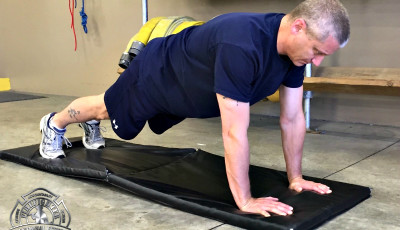8 Foundational Kettlebell Exercises for Firefighters
One of the keys to improving your functional fitness and fire ground performance is to use The Big 8 of Firefighter Functional Fitness as your foundation. The Big 8 concept is comprised of Core Strength, Cardiovascular Capacity, Flexibility, The Push, The Pull, The Lift, The Carry, and The Drag.
The Russian kettlebell, when used properly, is an incredibly efficient and effective modality because it easily be applied to all components of The Big 8, and the individual exercises often improve multiple Big 8 components at the same time. In this article, we will share 8 fundamental kettlebell exercises for firefighters.
#1 – Core: The Kettlebell Two-Hand Swing
The kettlebell two-hand swing is an explosive hip-hinge movement that requires you to keep your core engaged and your spine in-line. Two-hand swings are about generating power from the hips, and to do this properly, your core must be strong. Most beginners make the mistake of “lifting” the kettlebell with their arms/shoulders. On the contrary, the core and hips should be doing all of the work and the kettlebell should elevate do to the body’s forward momentum.
Perform at least 200 swings in increments of 10-25 with 30 seconds of rest between sets for added cardiovascular benefit. “Heavy” kettlebell swings are also great for improving grip strength and forearm strength. Beginners can start with a 16 kg kettlebell (male) and an 8 kg kettlebell (female). To go heavy, select a weight increment one to two steps above the standard weight you use to do kettlebell swings (if you use a 24 kg kettlebell, use a 28 kg or 32 kg kettlebell for heavy swings). Here’s a demonstration:
#2 – Cardiovascular Capacity: Kettlebell Complexes
Complexes string together a series of kettlebell movements that are performed in sequence without stopping for rest. Depending on your level of fitness, perform 3-6 rounds of a kettlebell complex for an incredibly efficient high-intensity interval training (HIIT) session.
When performing complexes, your kettlebell weight will be lighter than when you use them to complete each specific exercise. For example, you may overhead press a 24 kg kettlebell for strength training, but you might use a 16 kg kettlebell when doing presses as part of a complex. Here’s an example of a double kettlebell complex:
- 5 Double Swings
- 5 Clean and Overhead Press
- 5 Snatch
- 5 Front Squat
- 5 Renegade Rows
- 5 Push-ups on the Bells
#3 – Flexibility: The Kettlebell Windmill
You may not realize it, but certain kettlebell movements are great for improving your flexibility while increasing your strength at the same time. The kettlebell windmill requires core strength, mobility, and stability. Start with body weight windmills to build your technique, then add a light kettlebell to the mix for added benefit. With the kettlebell in right hand, point your feet at a 45 degree angle to the left, press the bell overhead, push your right hip out slightly, and trace your left hand down the inside of your left leg slowly. Repeat the process with the kettlebell in the left hand. Watch this demonstration video for more:
#4 – The Push: Kettlebell Overhead (Military) Press
The kettlebell overhead press is hard to beat for developing the muscle groups most used during firefighting tasks (triceps, shoulders, chest, upper back). There are many options when it comes to overhead presses (single kettlebell press, double kettlebell press, alternating see-saw press, single and double clean and press, squat press, and push press, to name a few). As with most kettlebell exercises, executing overhead presses requires an engaged core as well as upper-body strength. Watch this video that demonstrates the double kettlebell overhead press and the double kettlebell front squat:
#5 – The Pull: Kettlebell Renegade Row
Kettlebell renegade rows can be done with a single kettlebell (on one side then the other), or with two kettlebells at the same time. Once again, you must engage your core and maintain an in-line spine, so renegade rows offer the added benefit of core strengthening, increased grip strength, and improved ergonomic lifting technique. Remember to keep your elbows close to your torso. For added benefit, choose asymmetrical weights to improve balance. Watch this quick demonstration:
#6 – The Lift: Kettlebell Squats
Simply put, kettlebell squats are unrivaled for increasing leg strength and building both cardiovascular and muscular endurance. They are not fun, but they are highly effective. Options include the single kettlebell goblet squat, the single kettlebell front squat, and our favorite, the double kettlebell front squat. Watch this demonstration of a kettlebell “cadence” goblet squat, and feel the burn!
#7 – The Carry: Kettlebell Farmers Carry
In firefighting and in fitness, to get better at something, we simply must do that “something.” The kettlebell farmers carry mimics carrying techniques used often on the fire ground. Choose two relatively heavy kettlebells, and carry them at arms-length with spine in-line and “proud shoulders” for at least 50 feet (this will improve your grip strength as well). Mix up your weights to improve balance, and execute rack hold (chest level) carries and overhead carries as well to improve carry capacity and core strength. Here’s a quick demonstration:
#8 – The Drag: Kettlebell Bear Crawl and Drag
Crawling is one of the most effective exercises anyone can do to strengthen most major muscle groups and improve cardiovascular capacity at the same time. For firefighters, we often must crawl while dragging objects as well. Add a kettlebell to your bear crawl by crawling two paces forward, then reaching back to drag the kettlebell forward. Watch a demonstration here:
Take your fitness and health to the next level with Firefighter Functional Fitness. Visit FirefighterFunctionalFitness.com to learn more.

